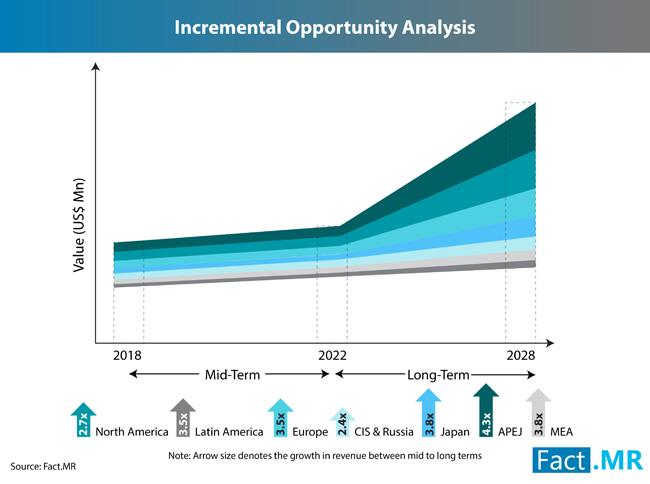According to the report, the widening expansion of 5G cellular networks will remain predominantly responsible for the growth of the market as well the continuing penetration of smart devices and connected technology.
The RF power amplifier market in Asia Pacific (excluding Japan) currently accounts for a sizable share (<50%) of the total revenue of RF power amplifier market, whereas North America’s RF power amplifier market holds over one-fourth of the total value represented by the RF power amplifier market.
North American and European RF power amplifier markets are expected to exhibit high CAGRs, due to the booming consumer electronics sector. However, the strong presence of some of the leading RF power amplifier manufacturers will continue to enable Asia Pacific (excluding Japan) to remain the leading RF power amplifier market throughout 2018-2028, accounting for nearly 40% of the total market.
The report suggests that the adoption of energy-efficient equipment, coupled with swift progress of the semiconductor industry, will further accelerate the growth of RF power amplifier market in Asia. In terms of sustainable value generation in RF power amplifier market, China, South Korea, and India are expected to drive demand for high-performance analogue semiconductor components, boosting the demand for RF power amplifier. Another strong factor driving the growth of APEJ market for RF power amplifier is consistently rising deployment of the next-gen wireless network and LTE network.
The first half of 2018 saw the first test for the first ever commercially available RF FEM specifically designed for 5G applications. Similarly, the designs of 5G FEM were tested for IoT and LTE. The companies involved in this innovation, NI (National Instruments) and Qorvo (a leading RF chipmaker), consider the results of this testing to deliver the desired wide bandwidth for the testing of 5G efficiency. Fact.MR is projecting a series of dynamic changes in the RF power amplifier market space, as both 5G and IoT gradually take over the technology world.

Established and newly entering semiconductor manufacturers in certain economies, including China, India, Japan, and the US are expected to drive the development of new business models among RF power amplifier manufacturers by augmenting the demand for advanced consumer electronics and network products – pushing the IoT and wireless infrastructure areas further.
RF power amplifier manufacturers are focusing on increasing investments in technology upgrades. The onus has shifted to revamp legacy models to improve operational efficiency. Evolving end-user demand has also meant that manufacturers of RF power amplifier have to make consistent size/weight reductions, while increasing the power density of amplifiers. Investment into R&D of the next generation of multi-mode RF power amplifiers will potentially play a pivotal role in enabling businesses address the challenge of adapting the legacy platforms to support modern business operations, thereby unlocking infinite opportunities of growth in the RF power amplifier market in the near future.
Cree recently announced the acquisition of the assets of Infineon Technologies' Radio Frequency (RF) power business, which is expected to trigger the expansion of its existing product portfolio and customer base. Moreover, industry experts foresee this acquisition as strengthing Cree's market position in RF GaN-on-SiC technologies.
MACOM also introduced the new MAGM series of GaN-on-Si based MMIC (Monolithic microwave integrated circuit) power amplifiers, specifically optimised for the 5G wireless base station infrastructure.
More recently, NXP Semiconductors announced the launch of its 5G RF front-end portfolio for massive multiple-input multiple-output (mMIMO) systems, i.e. the key ingredient of 5G networks.













